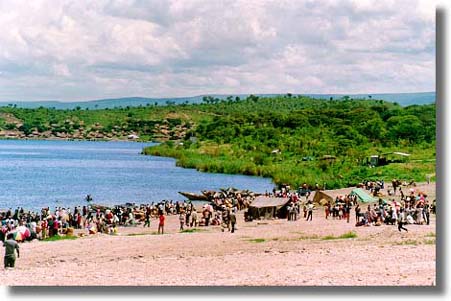
Peace Corps Programs in Zambia
Zambia is a landlocked country in central-southern Africa surrounded by Angola, Botswana, Malawi, Mozambique, Namibia, Tanzania, Zaire, and Zimbabwe. With a total land area of 752,614 square kilometers, Zambia is roughly the size of Texas and covers 2.3 percent of Africa's total area. The tropical climate consists of three distinct seasons including a warm-wet season from November to April, a cool dry season from May to August, and a hot dry season during September and October. The average altitude is 1,127 meters above sea level.
The geography can best be described as a moderately well forested plateau with larger areas of savanna in the south and west. Mountainous regions are found in the extreme north and eastern sections, bordering Tanzania and Malawi. Major river systems include the Luangwa in the North and Eastern sections of the country, the Zambezi in the West and South, Luapula in the North and Kafue Running from Central-North to South.
The country is divided into nine provinces and 61 districts with 73 ethno-linguistic groups, the predominant ones being Nyanja, Tonga, Lozi, Bemba, Luvale, Kaonde and Lunda. English is the official language throughout the country. The majority of the population (98 percent) are Christian.
Recent estimates put the population of Zambia over 10 million. The total fertility rate is estimated at 5.6 children per woman of childbearing years, and it is estimated that 55 percent the country's population is below the age of 18 years. There has been a steady urban migration since 1969, placing 43 percent of the population in urban centers of Lusaka and "the line of rails," an industrialized area leading through the Copperbelt Province.
The country experienced severe inflation through the 1990s, with the impacts still being felt today. Recent changes in government, efforts to open up the Zambian markets and economy, and 1992 and 1994 droughts have induced several foreign governments to increase their relief and development assistance to the Government of the Republic of Zambia. Compared to other African countries, Zambia has a relatively low per capita income at $280 (average $350 in sub-Saharan Africa).
Zambia is the world's fourth largest producer of copper, with a production of nearly 360,000 metric tons in 1994. Historically, copper exports contributed to the majority of the country's foreign exchange earnings and provided the leading source of employment. However, the drastic decline of the copper market values in the mid 1970s, the slow rate of industrialization, and a high dependence on foreign imports drove the economy into an extended period of decline.
Formerly known as Northern Rhodesia, Zambia gained independence from the British in October 1964. Dr. Kenneth Kaunda, the leader of the United National Independence Party (UNIP) was named as the first president of the Republic. Inspired by socialist theory, "humanism" was the guiding philosophy of UNIP, and focused on building a fair and classless society by placing the human being at the center of development activities. In November 1991, The Movement for Multi-party Democracy (MMD) won Zambia's first free presidential and general elections since 1968 and Frederick Chiluba was sworn in as the second president. The MMD government has focused on reversing Zambia's decline by taking on economic and public sector reforms.
A Peace Corps country assessment in early 1992 found that the majority of people did not have access to safe drinking water, proper sanitation facilities, and adequate nutritional input. With these challenges set, the first 12 Water and Sanitation Trainees arrived in February 1994. Since then, the program has grown quickly to encompass the four project areas of Health, Aquaculture, Environment, and Education, with Volunteers in seven of Zambia's nine provinces.
Health
Health Volunteers work with counterparts at various levels, from the rural communities to the district office, to promote preventive solutions to health, water, and sanitation problems. This project is based on the principles of allowing communities to define their own problems and take the initiate to solve them. One highlight of the project is the utilization of village development contracts that are signed by the individual village development committees and Peace Corps. This contract provides for the responsibility of each local organization to take on ownership of the project through cash contributions and physical assistance in the construction and maintenance of the projects. Additionally, Volunteers assist communities increase their capacity to asses their own health care needs and potential interventions and by promoting preventive solutions to health problems.
Aquaculture
Considerable potential exists for fish production to serve as an important agricultural activity in Zambia, where Aquaculture Volunteers are assisting the Department of Fisheries realize the possibilities. Volunteers provide technical assistance to rural farmers to help them assess their needs and resources, and then establish ponds and irrigation systems necessary for fish production. The primary benefits of increased fish production are income generation and improved health through an additional food source that is rich in protein. Anticipated benefits also entail improvement of the farming system through agricultural integration.
Environment
The Zambian Wildlife Authority has invited Peace Corps Zambia to join in an initiative with communities living near Game Management Areas who have recently gained an economic stake and a voice in managing these protected areas. Environment Volunteers have assisted community members develop the group decision making skills necessary for their new responsibilities, as well as to educate them about environmental and conservation issues. Volunteers work with communities to improve natural resource management techniques, improve their food security, establish environmental education initiatives, and seek to create links in the community between education and natural resource management.